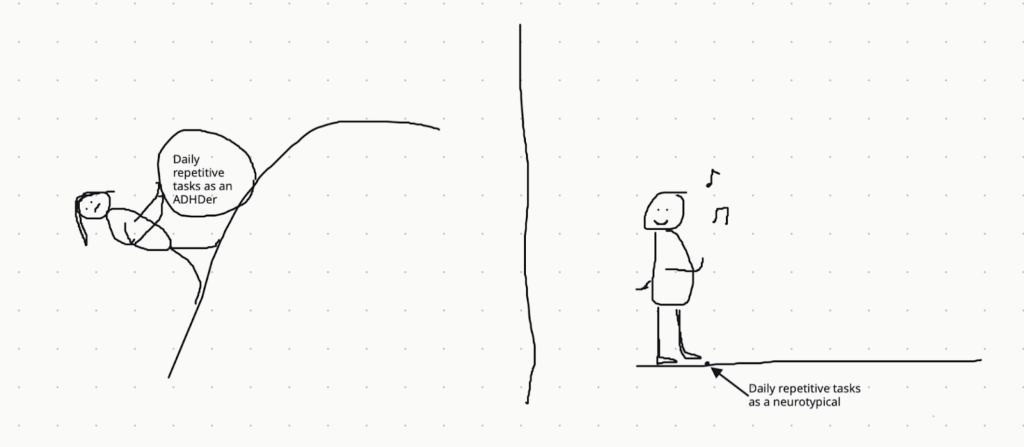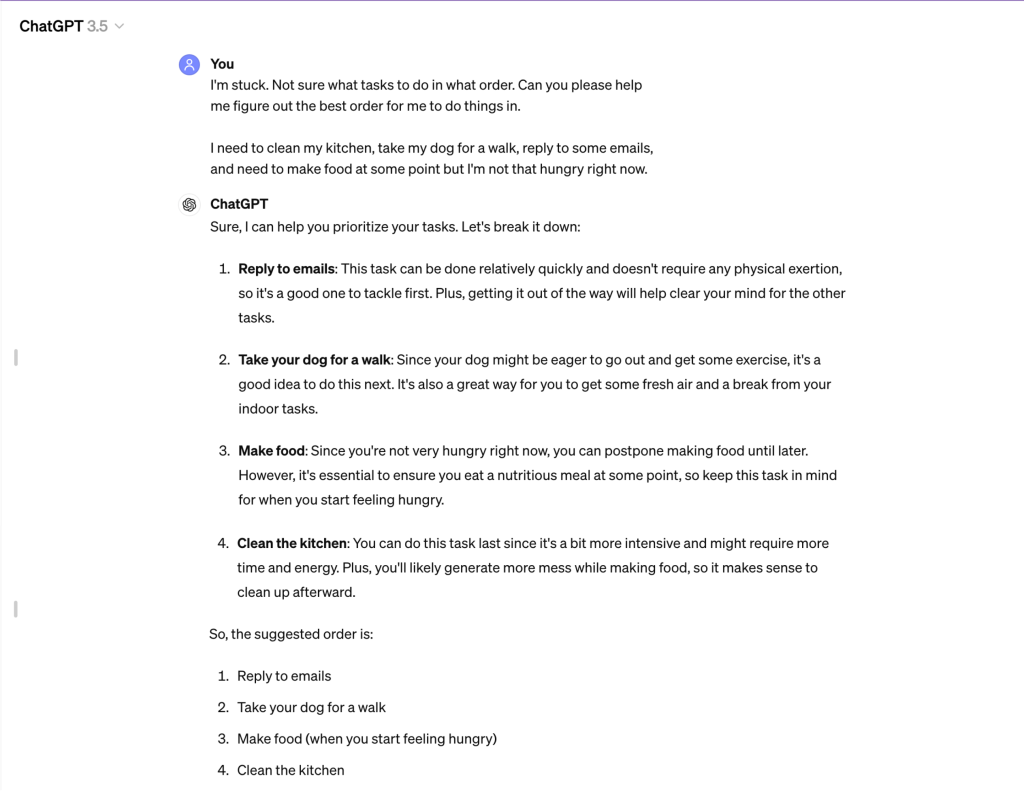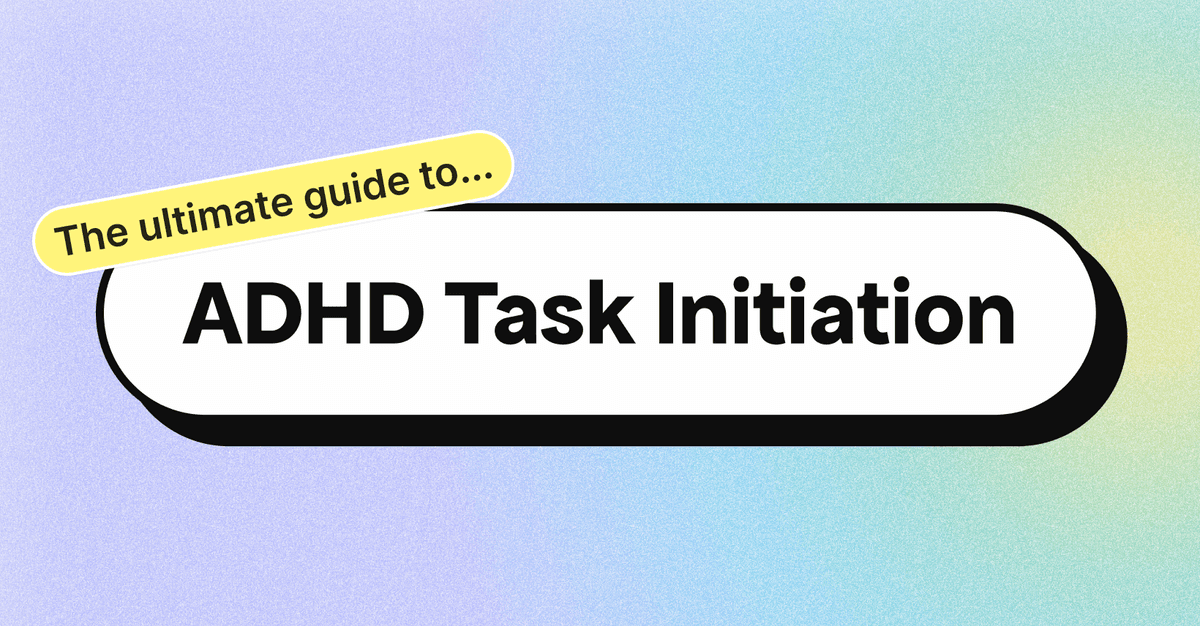We’ve all been there. You wake up on a Saturday and groan, thinking about all the things you need and want to do. You tell yourself “Just one more hour and then I’ll start” but you’re fighting with yourself like it’s 2004 and you’re Barbie in the PC game Barbie Explorer struggling to get out of the quicksand (niche reference or core memory unlocked?). Then 4 pm creeps around and it feels like the entire day is done and now you’re REALLY too tired to get started. “I’ll do it tomorrow” you say, probably at least a little annoyed at yourself. But then, the cycle repeats and the task feels even more daunting to start than it did the previous day.
I was actually working on another blog post until it came down to starting the writing part after the research was done and I completely froze. I was stuck. No matter how hard I tried over days I just could NOT get myself to do it. That got me reflecting on my life-long struggles with task initiation. So in my typical ADHD fashion, I went down a research rabbit hole to learn as much as I could about it. If I’m being honest, I decided to write a blog post on it at least 50% just for the bit (come on it’s funny to have to start writing a blog post on how to start something when you can’t start something). But I ended up reflecting a LOT on my life experiences, talking to other ADHDers, and wrote 20+ pages of notes from research papers so I’m confident there’s something here on task initiation that can help you too.
So let’s get started (ba dum tss 🥁 – get it, cause the article’s on task initiation 😉)
What is task initiation anyways?
Task initiation is, like it sounds like, well… initiating a task. It’s the process of figuring out the first step of a task so you know where to start and then actually getting started without procrastinating or putting it off.
Task initiation is a core executive function skill (one of the key skills that helps you get things done).
Why are task initiation strategies important?
Aside from the obvious reason of helping us achieve our goals, dreams, and ambitions, having effective task initiation strategies is important because of how they can support our well-being and quality of life. For example, some research shows that executive functioning challenges (like trouble starting tasks) is one of the main things that causes lower mood and distress in ADHDers.
Good task initiation strategies are especially helpful for tasks that we’re not interested in or aren’t motivated to do in the moment.
Who struggles with task initiation?
Literally everyone on the planet (or at least everyone I’ve ever met in my life) struggles with starting things sometimes. It’s definitely a normal part of the human experience. But some neurodivergent people can struggle with task initiation more than others. Specifically, task initiation difficulties are common in ADHD, depression, anxiety, and autism, just to name a few neurotypes.
I’m focusing mostly on ADHD and anxiety in this article because it’s a huge part of my own current personal experience but it’s not like brains fit into neat boxes and the tips below can be good to try regardless of what your neurotype(s) are if you’re struggling. As always, take what works and leave what doesn’t! And don’t give up, it might take some experimenting to figure out the best strategies for you.
Why do ADHDers have trouble getting started?
From my experiences, there are four main reasons why ADHDers have trouble with task initiation. You can identify your personal reasons by seeing which of the following statements you mostly closely relate to when there’s a task you just can’t seem to get started on.
1. I’m scared. I’m overwhelmed. I can’t do this – at least not right, quickly enough, or perfectly.
Lots of ADHDers report high levels of anxiety, being detail oriented which can lead to ‘overthinking’, and a fear of failure or lack of confidence which may or may not come from previous negative experiences. We might have the tendency to build things up in our heads, think about everything that can go wrong, or fixate on our self-perceived lack of ability to get a task done well which can make it feel like an impossible task – and impossible tasks can feel impossible to start.
Brendan Mahan coined the term the Wall of Awful to refer to the kinds of emotional blockers that come from tasks we’ve previously been unsuccessful at – like failing to get started on something at a specific time we said we would. Over time, our feelings around these experiences can build up and get in the way of us taking risks and just starting on the things we want to.
2. I can’t decide what to do!!!
This could include having trouble managing competing priorities, not knowing how to go about starting, having trouble “chunking” or breaking up the task, or being perfectionistic about the process.
3. I’m bored and I don’t want to. I hate that I have to do this right now. This is going to take forever and I’m in pain thinking about that.
Self explanatory.
4. I’m dreading a specific part of the experience of the task.
This usually takes one of two forms for me:
- Dreading the sensory experience. For example, I might have trouble doing dishes because I hate the way it changes how my hands feel and I’m expecting that.
- Dreading the emotions the task might bring up. For example, sometimes I can have trouble starting on a writing assignment because I feel like I’m an inefficient writer and that writing and being inefficient again will bring up those feelings and reinforce them in me, making me feel worse about that part of myself than I already do.
While all might just feel like a different flavour of “I feel like I’m stuck” to you, it can be helpful to figure out what the specific reason is behind your difficulty getting started to help you pick helpful strategies for dealing with it. For example, if you’re bored, you might want to try making the task more fun or interesting somehow. But if anxiety/perfectionism is the root cause, it might be more helpful to have some words of encouragement or some help getting started from a supportive friend or partner.
I’ll go into more detail about different strategies you can try out below. As you’re going through the strategies, feel free to reflect or take a note of what specific tips might help in different situations for you.
Does the type of task make a difference for ADHDers? Having an Interest Based Nervous System
A common misconception with ADHD is that we can’t pay attention to anything. But most experts know that ADHD is more of a difference in regulating attention, rather than a lack of attention itself.
If you’re an ADHDer, this might look like having the ability to be super hyper focused on something that you’re intrinsically interested in (like doing a deep dive into the cool new fact you’ve learned), but struggle to do things you know matter but that you find, well… boring.
In my life, I know things like brushing my teeth, showering, and doing laundry are all important. But it’s SO hard to get myself to do them, even though I theoretically want to, know I should do them, and often feel guilt/shame over not getting them done. Doing them feels like I’m Sisyphus forced to deal with the task of pushing a massive boulder up a hill each day (i.e., it takes me forever and I dread it), whereas for my neurotypical friends, it’s more like they accidentally kick a pebble while walking and continue on just whistling happily on the flattest path you’ve ever seen.

Some ADHDers think about themselves as having an interest-based nervous system. William Dobson came up with this term to describe how ADHDers can struggle with situational demands. Although ADHDers can do things sometimes, it’s often inconsistent and can be hard to perform “on demand”, especially when we don’t feel like it. He argues that for lots of ADHDers, boredom and lack of engagement can feel almost physically painful and make us feel irritable, tense, and like we have no energy to do things.
Basically he’s saying that ADHDers performance, mood, and energy levels are in large part determined by four key things:
- Interest (i.e., being fascinated by or passionate about something)
- Challenge or competitiveness
- Novelty/newness (creativity)
- Urgency (which usually comes from an externally imposed deadline)
Without any of these things present in a task, it can be really hard to make things happen.
In comparison, many neurotypical people have an importance-based nervous system. They’re able to more easily engage in tasks because the task matters a lot, is valuable to do/has a reward for doing it, or has a punishment/consequence if it’s not done. An important difference is that for neurotypical people, urgency matters less: tasks don’t have to be important right now to prompt engagement, just important in general. They also have an easier time prioritizing tasks in order of importance than we ADHDers usually do.
It’s almost like we ADHDers are cable TV where we’re forced to watch whatever’s on, while non-ADHDers operate more like Netflix where they can start something whenever and have a lot more choice over what they’re engaging in and focusing on.
Tips for ADHD Task Initiation with Examples
Unfortunately, the majority of the world isn’t built for ADHDers. Lots of the conventional planning systems and organization tools out there focus on importance, priority, and time, which often don’t meet the needs that ADHDers have to engage our brains. But these tips should help you get in the zone and “lock in” 😎.
Remember not every strategy here is going to work for everyone -> take what works and leave the rest. For example, one of my friends had this app on her desktop that would show her the average number of days she had left before she died every day to motivate her and that is NOT the vibe for me just personally… and that’s okay.
🌟 Give yourself time to transition into the task/gear up to do the thing
If you know you need to do a thing but don’t want to do a thing ahead of time, give yourself time before you need to do something just to relax and get yourself mentally prepped to get into it.
This can be super helpful if you tend to try and will yourself to do something “now” and feel bad about procrastinating it hours later, or tend to beat yourself up over not starting right away.
How to use the strategy:
- Instead of viewing yourself as procrastinating/putting something off, reframe it to your body/brain needing time to gear up.
- Positive self-talk can make a difference. Recognize your brain’s needs, have self-compassion, and try to minimize the shame you feel around taking time to get into things. If you need that time, that’s okay! There’s nothing wrong with that. And taking that time is productive because it’s part of the process of you creating an awesome thing.
- Plan to take time for yourself before you go into a dreadful task. Plan to give yourself two hours to set yourself up for success -> like getting coffee and food, watching a few episodes of your favourite Netflix show, or going outside. An hour in, gear up and start planning to get into it, mentally accepting that you’re going to start soon but you still have time and you’re not rushing into it.
- In my experiences, this can help me feel less stressed/bad about the time I need to start, and makes me feel something along the lines of “I feel rested now, I’m excited to do this thing I want to do now that my brain/body is more resourced to do it”.
- Put transition time between tasks/activities into your mental plan or schedule. For example, schedule meetings for 50 minutes and give yourself 10 minutes to mentally gear up and prepare your environment to get into the next task on your list.
🌟 Add energy – get creative to make it new, fun, engaging, and/or interesting
Most of what we need to do in life eventually gets boring, repetitive, unchallenging, and repetitive (oh wait…)
Anyways, you know how when you make pasta you’re supposed to salt the water first before boiling the noodles for maximum deliciousness?
In this metaphor, salt = fun, while boiling the noodles = your main task.
If you’re dreading doing a boring, not-fun task, get creative and spice it up.
Get yourself hyped up/silly/chaotic/playful and use that momentum to your favor.
Examples of how to use the strategy:
- Instead of saying something like “I should clean my room”, put on some funky tunes and start wiggling around your room. Then casually start picking up clothes from your floor while wiggling till you drop them in your hamper.
- Pretend you’re a sims character and put on some adventure-y video game music
- Race against the clock -> see how much you can get done in 30 min
- Add novelty like by trying working on the floor or working in a new coffee shop
- Gamify it! Make boring tasks into a game/turn work into play. Like if you need to sort through old clothes, make it a fashion show with a friend. Or have a little competition and race that friend to see who can get their task done faster – drinks on the person that loses.
- Sprinkle in a complementary fun task where changing the nature of the task too much isn’t possible.
- For tasks where I need silence like deep focused writing, I try to add something stimulating in a different way – like having coffee, water, and a juicebox so I can switch between different drinks.
- When I used to study in university, I’d study while eating popcorn with chopsticks so I was doing something more stimulating with my mouth/hands to help keep me focused, or I’d recite my notes while pacing around, throwing a ball, and saying sentences in sillier voices.
- Make a meaningful connection to your context – can you relate it to your life, your personal passions, or other things you find interesting?
- Have fun first. Sort of a combo of this tip and the one before it, give yourself permission and time to play before working and use that momentum and the increased dopamine levels in your brain to go, go, go. Some examples of things you can do are go for a walk in nature, play with a pet, listen to some music, dance, or do other activities you enjoy.
- Take a cold shower. You can also do things that don’t necessarily feel like fun but boost dopamine to add energy before starting.
- Research shows that taking even a short cold shower/bath has been shown to increase our energy, alertness, and improve mood, with people feeling more inspired and less distressed/nervous after a cold-water immersion.
- Note: what’s interesting or new to you today might not be interesting next week. Some of the solutions you try on this list might not last and that’s okay – you can switch it up to make it more interesting!
🌟 Make the task less dreadful or overwhelming to start
How to use this strategy:
- If you feel like you can’t do a task, give yourself permission to only do the task for a short amount of time and then stop and try again later if you feel like you can’t do more after the timer is up.
- I set a silent timer in a tab so I know when I can stop without pulling me out of my focus when it rings, and I almost always find myself working past it and just getting focused on my work and feeling motivation to complete it after doing this.
- In terms of duration, I usually set the timer for 5 min – 20 minutes because that’s what usually feels manageable to me (I’m like, I can try this for 5 min! It’s just 5 min!), but it can even be like 30 seconds if that’s what feels less intimidating/possible to you.
- This strategy works really well because doing something is what leads to motivation for lots of ADHDers. It’s like what they say in physics, “an object at rest stays at rest and an object in motion stays in motion”.
- Zoom out and imagine yourself as a tiny speck on Earth. If your troubles with task initiation are anxiety-driven, it can be helpful to remind yourself that most likely no one will die/it’s not going to be the end of the world if it’s not perfect
- Find ways to take the pressure off. One of my autistic friends in university wrote all their drafts in Comic Sans so it felt less serious and easier to begin.
🌟 For repeated tasks, get an accurate sense of how long it takes you.
A lot of ADHDers experience time agnosia, which can make it hard to feel time passing or estimate how long things will take us.
We’ve all been there: we’ve been putting off a task that’s taken up so much brain space for weeks, and then get it done in 5 minutes.
This happens because many of us have the tendency to see tasks that are emotionally intimidating as going to take us forever, even if in practice they won’t take that much time.
What makes it worse is the longer we put something off, the bigger it feels, which can make us put it off even more.
This can make something practically not that big of a deal like cleaning the kitchen, feel like it’s going to take the whole day.
So having an accurate sense of how long something will take where possible can make starting less scary.
Example of how to use the strategy:
- Find a task you don’t like which you have to do often (like dishes). Time yourself doing the dishes three times in a row to get a sense of how long it takes you. Then when you’re putting off dishes, you can say “It’ll only take up to an hour, that’s not so bad. I have an hour now, it won’t take forever, and I can listen to one of my favourite podcasts that has hour-long episodes while I do them”.
🌟 Chunk tasks into small steps and take it one step at a time.
It can feel overwhelming thinking about all the things you need to do during your day or even all the things you need to do to complete one task.
It can be easy for our brains to wander and think about everything which can make things feel way more overwhelming than they need to be and make us freeze.
It’s way more helpful to think about just opening up your computer with the right tabs or just figuring out an introduction, than it is thinking about the big, bad, multi-step task of writing out your whole paper all at once.
When you’re frozen (in the sky like a big pizza pie), focus on one achievable, specific step of one task at a time.
Examples of how to use the strategy:
- First brain dump and write all the tasks you need to complete down somewhere so they’re not taking up mental real estate with you feeling like you need to remember them/taxing your memory.
- Pick which tasks you’re going to focus on today (usually I like to have 1-3 must-do tasks or goals I want to work towards).
- Chunk tasks into doable and realistic steps that feel manageable to you. For example, instead of saying something like “I’m going to reply to all of my emails today”, something more constrained like “I’m going to reply to emails for 1 hour today” can help.
- If you struggle with breaking down tasks into realistic steps, I’d recommend asking a friend, team member, or AI tool to help. In addition to doing this sporadically as needed, I personally find it really helpful to have a weekly time with my co-founders where I get support prioritizing tasks for the week, broken up on a daily basis.
- Pick one step to focus on and put the rest away to help you focus on what you’re doing now.
- You can find ways to do this like having a whiteboard or sticky that says just your current step/focus, or momentum browser extension which has the option to see your current main focus.
- When you catch yourself thinking about the tasks ahead or jumping around to other tasks, tell yourself: that’s a problem for you later. You don’t need to think about them now. In fact, it’s counterproductive to do. Refocus yourself on the one thing you need to do right now.
- Limit distractions and other tabs.
- Put your phone away outside of grabbing reach so you don’t have to re-start the task if you get distracted. Bonus is if you can find a way to make this task fun. For me, I put it in a little mushroom basket across my room and tell myself I can’t get it because it needs to take a nap in its mushroom home for the next 8 hours.
- If you need to have your phone with you, turn off non-essential notifications (like iOS devices have different focus modes).
- Pick an environment with the right level of stimulation for your needs. For me, I need an environment with basically no distractions so I’ll often choose to work facing a blank wall and in an environment that’s basically silent.
- Closing other tabs you need to work on helps you focus on one thing at a time. If this in and of itself is a task for you, using something like SessionBuddy can help.
- If you’re stuck, focus on the smallest thing you can do. For example, maybe you don’t feel ready to get out of bed, but you can wiggle your toes. After doing that, focus on the next step – shaking your legs. Great! Now focus on sitting up. Done! Now focus on standing and then woohoo you’re out of bed!
- Note: I’ve found letting a friend/family member/partner in on these strats helpful too so they can give me a push sometimes when I need it.
🌟 Get into the right mindset by repeating helpful reminders.
A lot of people expect to feel motivated and then start on a task. But for lots of ADHDers, the motivation comes after starting/taking action, not before.
For me, it can be really helpful to keep that in mind, along with the following reminders:
- I don’t need to feel motivated to start, or want to start to start.
- I can start even if the conditions for starting aren’t optimal.
- Getting started is the hardest part. It’ll get easier the moment I do.
- You’ve done hard things before! You can do this.
- Progress over perfection.
- Even if you don’t get everything done perfectly or can stay focused that long, any progress is better than no progress at all.
- For long-term goals: shifting mindset from “I can’t do it” to “I’m making progress towards it”.
With many of us being verbal processors, I find it especially helpful to say these to myself aloud and repeat them as I get myself geared up to get into it. There’s also some research that talking through what you need to do and giving yourself motivational affirmations out loud can help you perform better.
🌟 Do a 10 second tidy
Not sure if watching Big Comfy Couch was just an early 90s-2000s Canadian-core experience, but it’s a show that basically features Loonette the clown and her doll Molly solving problems while living on a comfortable large couch.
In every episode there’d be this thing called the 10-second tidy, where she says ready, set, go and then jumps into action, rapidly cleaning the mess she made.
As a kid, this would make me also jump into action with her and clean up whatever I could while watching.
But reflecting on it now, it’s kind of an amazing strategy that feels like this was built for ADHDers – the quick countdown, jump into action, and focused cleaning with another person for an achievable amount of time is exactly what most often kick starts my brain into task mode.
I recently learned about a similar concept from another ADHDer called Mel Robbins 5 Second Rule. To give a quick summary, the idea is that when you need to do something (like your alarm ringing in the morning and you need to get out of bed) you act out and do a task without stalling so your brain doesn’t overthink it and talk you out of it. When you feel the need to act on a goal, countdown from 5 and then physically move to take action on it at or before the timer’s up. 5-4-3-2-1 stand up!
How to use this strategy
- Try using a countdown and jump into it!
🌟 Use external structure/social support
I don’t miss much about being in school, but one of the things I miss most is that deadlines felt so… real.
As an adult, especially when I’m working for myself, it can make it hard to feel like the deadlines I set for myself actually matter.
Like if I need to clean and I say my deadline for doing it is on Thursday, it feels like no big deal to push it one extra day… and then another… and then another… and suddenly it’s been 3 months with the reminder “clean my room” ringing at 8 pm every day.
In times like these, I find it really supportive to be accountable to someone who’s not me, have social support to get started and mitigate the anxiety of needing to do it alone, and/or have an external, real-ish consequence to not getting it done.
I would honestly say the top, if not one of the top three things that’s worked for me for getting started on things I don’t want to do is getting social support, especially in remote-work settings where I don’t have others physically around by default.
It’s like jumping on the bandwagon of someone else’s energy around getting stuff done to get yourself engaged with your task.
Examples of how to use this strategy:
- Invite your (maybe sort-of-judgemental) friend/family member over so you know you HAVE to clean before then and give yourself enough time where you think you can realistically do it by then. Even if it’s not perfect, my room is always way, way less messy when I’m motivated by the fear of embarrassment
- Find an accountability buddy or set up a “body doubling” session where you’re working silently at the same time as someone else on your goal. A common way to do this is to be on a video call together and both silently be doing your own work. It’s like making an “appointment” to get started on something, and it works really, really well for a lot of ADHDers. Personally, I even use this strategy to brush my teeth sometimes where I’ll facetime a friend and we’ll do it together.
- If you’re really having trouble, taking it one step further and sharing your screen with a trusted person so you know that they know whether or not you’re starting the task can help.
- I also find it helpful if I’m anxious to ask my friend whether I can occasionally interrupt them to ask for their opinion/advice. You can also ask the other person if the other person is okay to interact/bounce ideas with occasionally. I think this helps because knowing there’s someone there that I can ask if I get stuck helps me feel less intimidated and more confident that I can make things happen, because I’m not just relying on my own judgment or fully alone if it turns out to be harder than I expected.
🌟“Name it to tame it”. If being anxious is the barrier, label your feelings to help.
This is a phrase coined by Dan Siegel who basically makes the case that by naming what we’re feeling, we can reduce the intensity we feel and make ourselves feel less overwhelmed.
This can be a particularly helpful strategy if anxiety is the main barrier to you starting a task.
How to use this strategy:
- When I’m stressed out, I like to externalize my feelings and say things either to a friend or just myself like “I’m scared!” “I’m overwhelmed” (usually in a silly voice tbh because it helps me laugh and feel like things are more manageable)
- A lot of times it can be helpful to get the permission of a trusted friend/family member/partner to brain dump and just list all your feelings around something. I’ll usually just ask something like “hey would you have the capacity for me to just talk through a task and the barriers I feel getting started. No pressure”.
- Important note: while research shows that labeling feelings can be really helpful in lowering distress in high-intensity situations where you’re feeling very stressed/overwhelmed, it can actually increase your anxiety if you’re not actually feeling a lot of negative emotionality around the task to begin, so keep that in mind when using this tip. Basically, you want to try labeling negative feelings when you’re feeling stressed, but not necessarily label negative feelings if you’re feeling just meh and not wanting to start the task for another reason.
🌟 Figure out where to start
Many neurodivergent people have a hard time figuring out the best place to start projects.
Because many people who struggle with task initiation also struggle with task prioritization, the task of figuring out where to actually start or what thing to do first can become a task in and of itself.
This is especially true if you struggle with perfectionism around the process of getting things done, or have a harder time making decisions in general.
But you need to decide where to start to get started. Here are a few things that can help:
How to use this strategy:
- If you feel like there’s no one immediate order, in most cases, the order probably doesn’t matter that much. If you’re comfortable, a lot of ADHDers find success just using a tool like a random spinner or numbering list items and rolling a dice to decide on what to do and get started from there.
- If you’re more like me however, you might feel like there has to be better orders and not feel as comfortable leaving it up to random chance. If you’re feeling this way, try asking a friend to help you prioritize or use a tool like Chat GPT to help (sometimes the AI is logical asf and at the very least it can give you a rationale that might help you come up with an order that makes sense to your brain – it’s always easier to edit than start from scratch!)

- Work backwards. Try and imagine what the end state looks like and work backwards to the beginning. If you struggle with this, you can also ask a friend or use an AI tool to help.
🌟 Set yourself up for success
How to use this strategy:
- Make sure the environment is right for your needs. Working in a coffee shop sounds great but not if you get overstimulated or can’t focus because of the chatter. I like scouting places ahead of time so I have a shortlist of places I know I can go to that on average work for my needs.
- It sounds basic but get a good night’s sleep. Sometimes we deny it and this can be really hard for ADHDers too but when we can get it it makes a big difference.
- Fuel your brain so it’s ready to go – I personally find having coffee and at least 20g of protein in the morning really supportive to improving my ability to get into focus.
🌟 Reflect on what strategies work best for you and find ways to help you remember them
After trying things, pay attention to when something works and add it to your toolkit.
I’m a forgetful person so sometimes even when something’s worked for me in the past, I can forget all about it.
How to use this strategy:
- From these experiences, I’d recommend you write down the strategies that help you and have them visibly accessible to you – like on a sticky note on your laptop or jotted on the planner you use every day… wherever you’re more likely to actually check when you need to start something. For me, this looks like sticking stickies on the lamp on my desk because it’s just above eye level when I’m sitting at my computer so it really reminds me that it exists as a resource.
🌟 Bonus tip for task re-initiation: make it awkward.
One of the problems with taking a break when working on something or being done for the day on a big task is knowing you’re going to have to do task initiation all over again. Making it awkward can help.
Example of how to use this strategy:
- A lot of ADHDers say that it can be helpful to leave something in an awkward place like leaving an essay mid-word or mid-sentence when you get up so you’re more likely to get back to it!
🌟 Expect to have to try new strategies and adjust periodically.
Keep in mind that for lots of us, what helps is the novelty associated with trying a new strategy too. So give yourself permission to try random different strats from this list. What’s novel now might not be in a few months from now and it’s okay to switch it up if something that used to give you energy isn’t anymore. It’s a common part of my process to switch up which are the primary most effective strategies for me, take breaks from certain strategies, and revisit them in the future.
So instead of using the exact same strategy again and again and expecting it to work forever, I would have a list of strategies that work for you and then do something like roll a dice or use a random spinner to choose which one you’re going to use that day, updating the strategies you use as needed.
🛠 Tools to Help with ADHD Task Initiation
- Session Buddy to help you close your tabs
- For chunking tasks up, try Goblin Tools
- For on-demand accountability buddy sessions, try Focusmate
- For social support from neurodivergent peer mentors who “get it” and are down to figure things out with you, check out the wildly supportive community at ND Connect
- Executive Function/ADHD coaching has also shown to help in some research for some people
References
- https://adhd.dk/wp-content/uploads/sites/2/2022/05/Dodson-How-ADHD-Shapes-Your-Perceptions-Emotions-.pdf
- https://www.youtube.com/watch?app=desktop&v=Uo08uS904Rg&t=1s
- https://www.youtube.com/watch?v=hlObsAeFNVk
- https://www.adhdessentials.com/wp-content/uploads/5-Ways-to-Overcome-The-Wall-of-Awful.pdf
- https://www.sciencedirect.com/science/article/pii/S1877042811008019
- https://www.ncbi.nlm.nih.gov/pmc/articles/PMC9953392/
- https://anxiety.org.nz/updates/name-it-to-tame-it#:~:text=Putting%20feelings%20into%20words%20can,emotion%2C%20and%20feel%20less%20overwhelmed
- https://www.ncbi.nlm.nih.gov/pmc/articles/PMC9799301/
- https://journals.sagepub.com/doi/full/10.1177/1053451220928978
- https://www.reddit.com/r/ADHD/comments/12r51k7/what_are_your_favorite_strategies_for_initiating/
- https://doi.org/10.32623/6.10011
- https://www.sciencedirect.com/science/article/abs/pii/S1750946721000143
- https://www.ncbi.nlm.nih.gov/pmc/articles/PMC5111802/
- https://journals.sagepub.com/doi/full/10.1177/1087054718804347
- https://journals.sagepub.com/doi/full/10.1177/1087054719900251
- https://www.sciencedirect.com/science/article/abs/pii/S0165032721006066



